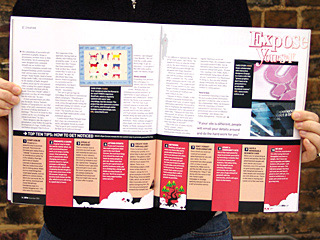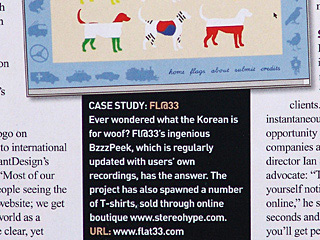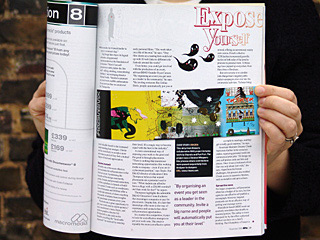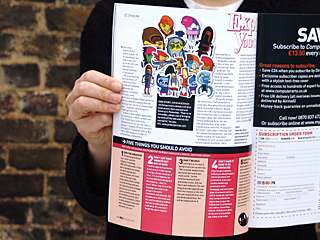PRESS ARCHIVE
Computer Arts, 115, November issue, Expose yourself, by Daniel West, FL@33 case study / bzzzpeek.com / stereohype.com, pp.34–40, London, UK, October 2005 (English)
___
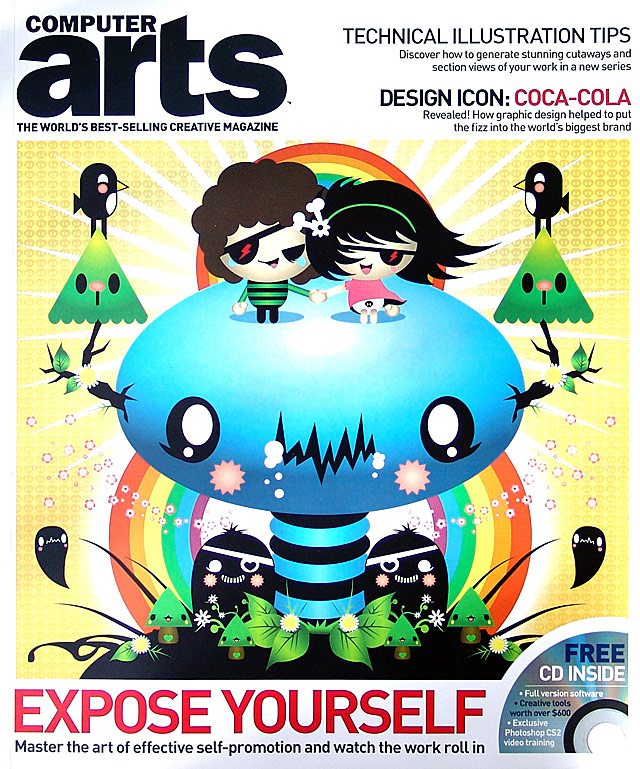
COMPUTER ARTS | EXPOSE YOURSELF EXCERPTS
|p.36| (...) Case Study: FL@33 | Ever wondered what the Korean is for woof? FL@33's ingenious Bzzzpeek, which is regularly updated with users' own recordings, has the answer. The project has also spawned a number of T-shirts, sold through online boutique stereohype.com. | flat33.com (...)
|p.40| (...) Similarly, FL@33 created a playful website named Bzzzpeek, which displays linguistic variations between countries through onomatopoeic words. The site has been plugged by the New York Times and visitors now peak at 15,000 per day. The noncommercial nature of such projects is the key to their success. The line between self-initiated and self-promoting may be fine, but the best projects combine assets of both. (...)
COMPUTER ARTS | EXPOSE YOURSELF
Designers look at self-promotion in the same way the British do sex – no-one admits to it, but everyone knows it’s going on. Daniel West puts on a dirty (Apple) mac to investigate the last taboo.
___ Ask most successful graphic designers what’s aided their career,…
(...) CONTINUE READING
…and “self-promotion” won’t crop up too often – after all, the term is usually regarded with a mixture of contempt and refutation.
___ In an age when design is regularly indistinguishable from art, to admit self-promotion is tantamount to admitting both that your work needs promotion and that you are spineless – or worse, arrogant – enough to do the deed. Yet the irony is that many top designers do engage in self-promotion on various levels. In fact, it’s pretty much impossible to get anywhere in design these days without promoting your work at some point. Why then, is there still this culture of denial?
___ Part of the problem is the stigma. Many designers eschew manufactured publicity, aspiring instead to the “my work speaks for itself ” approach. It’s undeniably attractive to have a steady stream of clients on the basis of reputation alone. Perhaps because graphic designers spend so much of their working life promoting products, doing so for their own work not only devalues its ultimate appeal, but also brings to light their uncomfortable role within society.
___ As John O’Reilly noted in Eye 38, “You could say that the difference between the self-publicist and the self-motivated is that the former has something to sell, while the latter has something to say. Yet the paradox is that the good designer exploits content by being its slave.”
___ The question remains: where does that “good designer” reputation come from, and how is it communicated to both clients and peers?
The cornerstone of successful self-promotion in graphic design is presentation, nowhere more so than the portfolio. Yet it’s amazing how many designers turn a potential strength into an Achilles heel.
___ Common complaints include over-designed housings, poorly mounted work and too many chocolate bar designs. Stuart Hardie, head of music design studio Traffic, was overwhelmed by the number of badly designed Cadbury mock-ups he encountered while scouting for a junior designer. “One included a Kit Kat with the words “Give him a break” added. I can assure you they all went straight into the trash can,” he says.
___ A more personal touch can often pay dividends. Jeremy Tankard, founder of Typography.net, says that many of his early commissions came as a result of taking sketchpads to meetings. “The level of creativity they contain can be very revealing, and clients loved them,” he says.
___ Some designers take the impact of presentation a step further through the development of a logo. Graffiti artist and fashion designer Pure Evil is a firm supporter of the approach, having built an identity and clothing line around his mark. “A lot of clients have this “I know that from somewhere” look on their face, which means they’ve seen it on the street,” he says. As advertisers have long known, brand recognition is a powerful tool for manipulation, but there’s also a more immediate benefit – traceability.
“We aim to get our logo on everything, from flyers to international album campaigns,” IWantDesign’s John Gilsenan admits. “Most of our work comes through people seeing the credit and visiting our website; we get mail from all over the world as a result.” The benefits are clear, yet many top-flight studios prefer a more restrained approach.
___ London-based Made Thought think that a logo can communicate too much, and appear forced as a result. “You’ve got to give yourself impact, but that can be achieved through modesty,” says designer Chris Moorby. “We just went for a really subtle fluoro edge on all our stationery – it just gives it that little extra push to make our identity unique.”
Sticky content
___ Extending your presence into cyberspace is a natural, and cost effective, way of reaching new clients. Websites have an instantaneous global presence, an opportunity to reach millions of companies and collaborators. Mode’s director Ian Styles is an outspoken advocate: “The best way to get yourself noticed is to post work online,” he says. “It only takes a few seconds and if your site’s different you’ll get people emailing your details around, doing the hard work for you!”
Like any medium, there are drawbacks. Many websites struggle to attain depth with such a flat means of display, as Mode, renowned for print and environmental design, discovered when they created their own site. “It’s very difficult to represent the intricacy of our work online,” says Styles. “So instead we focus on what the media can do. We show attention to detail and thought processes through site navigation and image transition.”
___ However, building a great site is only half the problem; increasing traffic is essential, too. The virtual design community can be a real self-promotion boon. “You might not get loads of money thrown at you,” says Design is Kinky’s Andrew Johnstone, “but you’ll soon get feedback and great contacts for free.”
___ Gateway of choice, Google, is also essential to securing increased hits, although Nick Casey of search engine optimisation specialists Vectorcraft is keen to emphasise the importance of user experience over a vain pursuit of better stats. “Optimise for users first, bots second,” he advises. “It’s great to get better rankings, but if your site’s no good, what’s going to keep people there once they’ve arrived?”
___ This is the crux of online success: “sticky content”. Soho’s NowWashYourHands has fully embraced this concept, providing regular Flash toys on its site. Operation Slaps, the company’s most successful project to date, was an interactive piece based on the now notorious playground game. “It went viral, reaching USA Today, Radio 1 and eventually being taken off three servers,” remembers Gus Mackinnon. In doing so, they not only reached design enthusiasts, but millions of people the world over, from office workers to online gamers.
Face to face
___ It’s somewhat reassuring to learn that the post-modern global information age hasn’t eroded the value of face-to-face relationships. Many top designers stress the importance of human interaction at a personal level. “No promotional item is ever as effective as a meeting,” says design critic Adrian Shaughnessy. “Anyone can bin a mailer, but it’s much harder to say no to someone’s face.”
Cog Design takes this to its logical extension, using personal recommendation as the foundation of its business. “Most of our self-promotion is subtle, below the line stuff – talking, emailing, remembering birthdays,” says managing director Michael Smith. “Satisfied customers are much more credible ambassadors for our services than we could ever be.” Perhaps the most valuable benefit is the increased understanding that emerges. Clients are far more likely to accept a more adventurous pitch if they feel a mutual degree of trust and appreciation.
___ Expose yourself | Probably one of the most effective environments for self-promotion is the festival circuit. Synthesising the benefits of the design community, public forums and personal interaction, it offers a platform to launch or build on a career. Events such as onedotzero, Semi-Permanent and RESfest offer a worldwide network of shows reaching thousands of industry heavyweights and passionate amateurs every year.
___ “Festivals are a great opportunity to get your work seen by talent spotters,” says onedotzero’s Anna Doyle, and motion graphics director Ed Holdsworth is also sold on the benefits, recalling the “invaluable exposure” he received by entering early personal films. “The work takes on a life of its own,” he says. “One film shown at a touring fest could end up with 20 web links to different city festivals around the world.”
___ Even better, you could get involved with the production of an event, advises BD4D founder Ryan Carson. “By organising an event you get seen as a leader in the community,” he says. “By inviting someone like Joshua Davis, people automatically put you at their level. It’s a magic way to become equal with the best in the industry.”
___ A more conventional way of exposing your work to the great and the good is through placements. “There is nothing that maximises networking opportunities like working inside a company – even if you are in a placement position,” says Doyle. But D&AD director of education Chris Thompson believes that unpaid placements are a potential road to ruin. “What student can afford to leave college with a £20,000 overdraft and then work for free?” he argues.
___ Thompson highlights the admirable D&AD Education Council scheme that encourages companies to pay for placements. Despite this, it’s clear that internships offer more in the way of experience and contacts than direct self-promotion opportunities.
In a market this competitive, it pays to look for cost effective strategies to get your work seen. The street is arguably the most cost-effective option around, offering an unrestricted, widely seen canvas. French collective 123Klan has incorporated guerrilla tactics on both sides of the pond to promote its personal work. 123Klan tags have popped up everywhere from Barcelona to Bordeaux.
But not everyone is so cavalier. John Burgerman’s targeted public sticker campaigns cross over into his commercial activities. “I always bring a couple to meetings, and they get a really good response,” he says.
___ American illustrator Deanne Cheuk went even further in the crossover stakes, squeezing personal work into commercial print jobs: “I’d design my own self-promo cards and bits and pieces. Once it was a bookmark sliver that was only about 2cm wide,” she says. Apart from the format challenges, this process also enabled Cheuk access to expensive finishes, such as metallics and spot colours.
Spread the news
___ For larger companies, self-promotion often has a budget of its own, but few agencies can afford to self-publish a monograph. However, targeted postcards can be an effective way of getting your message across.
Shoreditch-based GRDD send out quarterly newsletters that double as seasonal posters. The outlay is more than paid for by the effect a physical product can have on a client’s thinking. Paul Humphrey of Insect is also a firm believer in the power of print: “If it’s something I can hold, it may end up on the wall, and then there is a constant reminder of that person.”
PR is essential but there are plenty of contrasting tactics. NowWashYourHands appreciates the expertise of external PR teams, while others such as Studio Output prefer an in-house approach, arguing that the “message isn’t lost by an intermediate party”. Magazine advertising is a bolder approach still.
___ Freelancer Ben Miners appreciates the consistency it offers, so that even if he “doesn’t have work in the editorial section” he can still “have a presence”. Topping off these activities is the agency. Companies such as Big Active offer designers a range of services from collaborative opportunities to creative management. Alongside a reliable flow of jobs, they can provide career guidance. The forthcoming bikini range by Jasper Goodall is a perfect example – a self-promotional project made possible by Big Active’s capital investment. Ironically, perhaps the best form of self-promotion is work that shies away from the task at hand. Australian collective Rinzen began life with a spontaneous project that resulted not only in widespread coverage online and a Die Gestalten Verlag-published book, but also official formation of the studio. Collaborating with over 30 designers to “remix” each other’s work they had “no commercial aspirations” and were “simply creating for enjoyment”.
___ Similarly, FL@33 created a playful website named BzzzPeek, which displays linguistic variations between countries through onomatopoeic words. The site has been plugged by the New York Times and visitors now peak at 15,000 per day. The noncommercial nature of such projects is the key to their success. The line between self-initiated and self-promoting may be fine, but the best projects combine assets of both.
___ The most important strategy is professional commitment, however. Delivering a job on time, on brief and under budget is what really brings in the clients. As Ian Anderson, head of self-promotion pass masters the Designers Republic, says: “Most clients want to see what you can do for them, not for yourselves.” Promoting yourself is only half the battle. You must also ensure that your clients come back.

